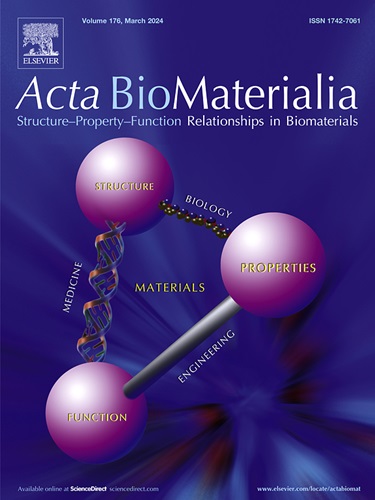利用定向超声剪切波同时测量人体骨骼肌组织的拉伸、剪切弹性和各向异性。
IF 9.4
1区 医学
Q1 ENGINEERING, BIOMEDICAL
引用次数: 0
摘要
以优先方向排列的复杂蛋白质纤维网络增强了承重骨骼肌组织,赋予了方向依赖的机械性能(各向异性)。表征这种体内各向异性对于理解正常和病理肌肉功能以及结构完整性至关重要。然而,目前的非侵入性技术在精确测量各向异性组织(如骨骼肌)的机械性能方面受到限制。在这里,我们使用了一种创新的角度分辨超声弹性成像方法,该方法是我们团队最近开发的,可以同时量化拉伸和剪切弹性以及各向异性,从而全面评估肌肉生物力学。我们充分描述了14名健康年轻人在被动和主动轴向载荷下肱二头肌的力学特性,揭示了沿着和跨肌肉纤维的不同剪切和拉伸力学行为。值得注意的是,拉伸和剪切模量沿主纤维方向被发现是不耦合的,而跨肌肉纤维测量显示出一致的模量比为3.4±0.2,无论轴向加载条件或强度如何。这些发现突出了骨骼肌的各向异性性质,并为其体内力学行为提供了有价值的见解。剪切和拉伸各向异性均随肌肉轴向生理负荷的增加而增加,表明我们的方法对各向异性组织力学的变化很敏感。最后,我们证明了角度分辨超声剪切波弹性成像提供了剪切和拉伸特性的直接估计,为临床应用提供了重要的前景,包括神经肌肉疾病的诊断和监测,用于预测组织对载荷和治疗反应的生物力学建模,以及组织工程。意义声明:传统的超声剪切波弹性成像技术忽略了骨骼肌的各向异性,导致不完整的组织力学表征。在这项研究中,我们利用一种创新的角度分辨弹性成像方法来评估人体肌肉的拉伸和剪切弹性,以及它们的各向异性因素。我们首次揭示了主动和被动生理加载过程中拉伸和剪切弹性之间的复杂关系。这项技术增强了我们对肌肉力学的理解,并在肌肉健康和神经肌肉疾病管理方面具有很好的临床意义,其中组织结构和机械特性经常被改变。此外,它可以帮助开发肌肉组织的本构模型,并有助于组织工程材料的设计。本文章由计算机程序翻译,如有差异,请以英文原文为准。
Simultaneous measurement of tensile and shear elasticity and anisotropy in human skeletal muscle tissue using steered ultrasound shear waves
Load-bearing skeletal muscle tissues are reinforced by intricate networks of protein fibers aligned in preferential orientations, imparting direction-dependent mechanical properties (anisotropy). Characterizing this anisotropy in vivo is essential for understanding both normal and pathological muscle function, as well as structural integrity. However, current noninvasive techniques are limited in their ability to accurately measure the mechanical properties of anisotropic tissues such as skeletal muscle. Here, we used an innovative angle-resolved ultrasound elastography method, recently developed by our team, to simultaneously quantify tensile and shear elasticity and anisotropy, enabling comprehensive assessment of muscle biomechanics. We fully characterized the mechanical properties of the biceps brachii in fourteen healthy young adults under passive and active axial loadings, revealing distinct shear and tensile mechanical behaviors both along and across muscle fibers. Notably, tensile and shear moduli along the main fiber orientation were found to be uncoupled, while cross-muscle fiber measurements exhibited a consistent modulus ratio of 3.4 ± 0.2, regardless of axial loading conditions or intensities. These findings highlight the anisotropic nature of skeletal muscle and provide valuable insights into its in vivo mechanical behavior. Both shear and tensile anisotropy increased with muscle axial physiological loading, indicating that our method is sensitive to changes in anisotropic tissue mechanics. Lastly, we demonstrated that angle-resolved ultrasound shear wave elastography provides direct estimates of shear and tensile properties, offering significant promise for clinical applications, including neuromuscular disease diagnostics and monitoring, biomechanical modeling for predicting tissue responses to loading and therapies, and tissue engineering.
Statement of significance
: Conventional ultrasound shear wave elastography techniques overlook the anisotropy of skeletal muscles, leading to incomplete tissue mechanical characterization. In this study, we leveraged an innovative angle-resolved elastography method to assess tensile and shear elasticity, along with their anisotropic factors, of human muscle in vivo. For the first time, we reveal the intricate relationships between tensile and shear elasticities during active and passive physiological loading. This technique enhances our understanding of muscle mechanics and has promising clinical implications for muscle health and neuromuscular disease management, where tissue structural and mechanical properties are often altered. Additionally, it could help in developing constitutive models for muscle tissue and contribute to the design of tissue-engineered materials.
求助全文
通过发布文献求助,成功后即可免费获取论文全文。
去求助
来源期刊

Acta Biomaterialia
工程技术-材料科学:生物材料
CiteScore
16.80
自引率
3.10%
发文量
776
审稿时长
30 days
期刊介绍:
Acta Biomaterialia is a monthly peer-reviewed scientific journal published by Elsevier. The journal was established in January 2005. The editor-in-chief is W.R. Wagner (University of Pittsburgh). The journal covers research in biomaterials science, including the interrelationship of biomaterial structure and function from macroscale to nanoscale. Topical coverage includes biomedical and biocompatible materials.
 求助内容:
求助内容: 应助结果提醒方式:
应助结果提醒方式:


